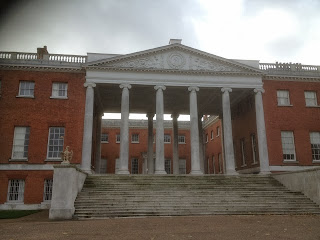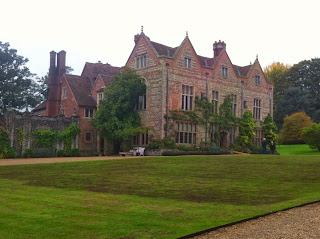Osterley Park is the reason that I started this blog. It was one of the first places we visited after we joined the National Trust and I spent a perfectly pleasant couple of hours there. But could I tell you anything about it afterwards? No. I'd forgotten every single thing before we'd even driven out through the gates.
Now, let's be honest here, forgetting stuff isn't good - it's a bit rude and also potentially life-threatening, if the thing you forget is how to cross the road or that you shouldn't take 50 paracetamol at once. But I have a very specific and terrifying fear about my National Trust membership; that one day I will end up on Who Wants To Be A Millionaire, only to hear Chris Tarrant say "For a million pounds then; who designed Osterley House in West London?" and my other half will be going "We went there last week! She knows it! We are rich beyond our wildest dreams!" only to see the sheer terror in my eyes and the already used phone-a-friend icon. That's why I needed to get a grip on things - there could potentially be a million pounds at stake.
So I started the National Trust Scones blog that you are reading now. And it has been remarkably successful in making me remember stuff. Ask me anything about Petworth, Ham House, Bodiam Castle, Brownsea Island, Lyme Park, Hughenden, Houghton Mill, Winkworth Arboretum, or Greys Court and, to paraphrase the great Craig David, I can fill you in.
To thank Osterley for inspiring me, I decided to return and make it the 10th destination on my scone odyssey. And I’m very glad I did, because I had forgotten how beautiful it is. The walk from the car park takes you round a very handsome lake and then you come face to face with the house itself:
So thank you Osterley for inspiring this blog and being so marvellously beautiful.
Scones: 4 out of 5
Now, let's be honest here, forgetting stuff isn't good - it's a bit rude and also potentially life-threatening, if the thing you forget is how to cross the road or that you shouldn't take 50 paracetamol at once. But I have a very specific and terrifying fear about my National Trust membership; that one day I will end up on Who Wants To Be A Millionaire, only to hear Chris Tarrant say "For a million pounds then; who designed Osterley House in West London?" and my other half will be going "We went there last week! She knows it! We are rich beyond our wildest dreams!" only to see the sheer terror in my eyes and the already used phone-a-friend icon. That's why I needed to get a grip on things - there could potentially be a million pounds at stake.
So I started the National Trust Scones blog that you are reading now. And it has been remarkably successful in making me remember stuff. Ask me anything about Petworth, Ham House, Bodiam Castle, Brownsea Island, Lyme Park, Hughenden, Houghton Mill, Winkworth Arboretum, or Greys Court and, to paraphrase the great Craig David, I can fill you in.
To thank Osterley for inspiring me, I decided to return and make it the 10th destination on my scone odyssey. And I’m very glad I did, because I had forgotten how beautiful it is. The walk from the car park takes you round a very handsome lake and then you come face to face with the house itself:
Osterley went further up in my estimations by having an
audio tour on offer to visitors. I love audio tours. I think that every NT property should have one. I was so excited that I forgot to pick one up for my trusty sconeing companion, so he had to walk round unaided with me occasionally shouting "THEY HAD A DAUGHTER CALLED SARAH-ANNE. SHE USED TO PLAY THE HARPSICHORD." at him.
(I will take this opportunity to advise you to avoid the audio guide at Whitby Abbey, should you ever go there, at all costs. Having remortgaged my home to cover the cost of entry, the audio tour turned out to be full of shrieking actors pretending to be nuns being burned alive. Dreadful.)
(I will take this opportunity to advise you to avoid the audio guide at Whitby Abbey, should you ever go there, at all costs. Having remortgaged my home to cover the cost of entry, the audio tour turned out to be full of shrieking actors pretending to be nuns being burned alive. Dreadful.)
But the Osterley audio guide is big on facts and low on
shrieking and so I am proud to share with you my Tarrant-defying-million-pound-winning factoids about Osterley.
- Osterley House was designed and built by Robert Adam, one of the pre-eminent architects of the 1700s.
- It is built in the neo-classical style, which incorporates Ancient Greek and Roman features into the exterior and interior.
- Adam had honed his architectural style by going on the Grand Tour of Europe.
- The house belonged to Robert and Sarah Child, who wanted a home that showed off their enormous wealth and cultural sophistication.
- The Childs made their money from his involvement with the Child & Co Bank and the East India Company!
The Osterley scones
BUT WHAT ABOUT THE SCONES I hear you ask. Well, I can tell you that they were very good - there was a choice of fruit or plain and they had a lovely crumbly texture that I liked a lot. Two scones, cream, jam and tea was £4.75:
BUT WHAT ABOUT THE SCONES I hear you ask. Well, I can tell you that they were very good - there was a choice of fruit or plain and they had a lovely crumbly texture that I liked a lot. Two scones, cream, jam and tea was £4.75:
Scones: 4 out of 5
Osterley Park: 4 out of 5
PS - I have just discovered that WWTBAM is being cancelled. I can sleep at last.








